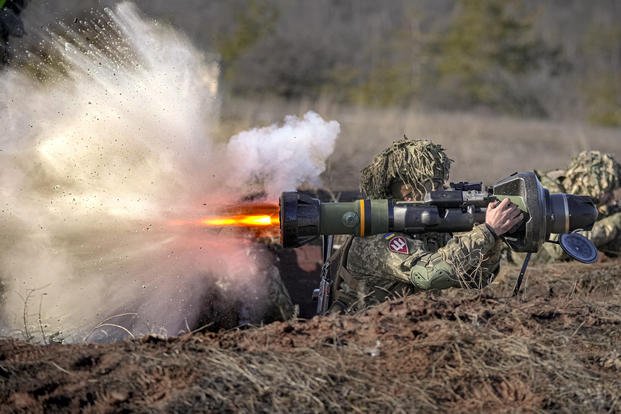US Troops to Train Ukrainians on Howitzers and Radars to Fight Russia in Major Shift

U.S. troops deployed to Europe will begin training the Ukrainian military on howitzers and radar systems as part of a massive new weapons and security aid package announced Wednesday.
The planned training is a major development in the U.S. involvement in the bloody Russian war on Ukraine and will put its military once again in direct contact with Ukrainian forces after U.S. troops left the country in the weeks ahead of Russia's invasion.
President Joe Biden has vowed that Americans will not fight in the country, and thousands of troops deployed to eastern Europe have so far only guarded the border of the NATO alliance as the conflict rages next door.
Read Next: Schriever Space Force Base Receives $30 Million for New Fitness Center
The new aid for Kyiv includes 18 of the U.S. military's 155mm howitzers and 12 counter-artillery and surveillance radar systems. The $800 million package -- the latest in a total of $2.6 billion worth of war support since February -- was approved by Biden on Wednesday as Russia's planned conquest of Ukraine appeared to enter a new phase in the eastern Donbas region and Moscow continued an assault on the key city of Mariupol.
The artillery and radars, including the AN/TPQ-36 Firefinder and AN/MPQ-64 Sentinel, were among a lengthy list of hardware worked out with the Ukrainians in recent days and will require the U.S. military to provide guidance on how to use them, Pentagon spokesman John Kirby said.
"We believe that we can put together appropriate training for some of these systems very, very quickly. These are not highly complex systems," Kirby said.
There are about 100,000 U.S. troops total in Europe, with about 14,000 of those being deployed in response to Russia's unprovoked invasion and floundering attempt to take over Ukraine, a former Soviet republic that has carefully nurtured independence and contact with the West since the end of the Cold War.
The Pentagon said details of who would provide the training and where it would occur had not been worked out on Wednesday.
"It's more likely than not that what we would do, because they are in an active fight, is a train-the-trainers program," Kirby said. "So, pull a small number of Ukrainian forces out so that they can get trained on these systems and then send them back in."
The security package also includes a myriad of other equipment. Ukraine is getting another 300 of the Switchblade drone missiles, as well as 11 Mi-17 helicopters that had been slated to go to Afghanistan; 2,000 optics and laser rangefinders; M18A1 Claymore anti-personnel mines; 200 M113 armored personnel carriers; 100 Armored High Mobility Multipurpose Wheeled Vehicles; chemical and biological protective gear; and body armor and helmets.
A mysterious "unmanned coastal defense vessel" will also be donated by the Navy. The Pentagon refused to provide any details on the vessel, which appeared to be a ship drone not known to the public.
U.S. troops may also be tapped to provide training to Ukrainians on the optics, Claymore mines and Switchblade drones. A small number of Ukrainians who were in the U.S. since before the Russian invasion on Feb. 24 have been trained on the drones, which are essentially flying missiles that can loiter over the battlefield. Those Ukrainians spoke with Defense Secretary Lloyd Austin on Sunday from Biloxi, Mississippi, before returning to Ukraine.
The U.S. and NATO allies have pumped weapons such as Stinger and Javelin missiles into Ukraine that may have been key so far in repulsing Russian forces and destroying its tanks and aircraft. The new weapons approved Wednesday could further help give the Ukrainians an edge as Russia appears to refocus its forces on the breakaway Donbas region in the east, and continues its assault on the southern city of Mariupol, where victory could give Moscow a new opening to take other areas of the country.
But Biden and the Pentagon have been careful about deeper involvement in the conflict over concerns of triggering an escalation. Russian President Vladimir Putin made a public vow of retaliation against any nations that oppose his invasion that was widely interpreted as a threat to use Russia's nuclear weapons.
Kirby said the U.S. training is just a continuation of the other types of support for Ukraine.
"This is a piece of that, and this is representative of the kinds of capabilities that Ukrainians themselves have asked for and said they need as this fighting now gets focused on the eastern part of the country," Kirby said. "How that gets interpreted by the Russians, you can ask Mr. Putin at the Kremlin."
-- Travis Tritten can be reached at travis.tritten@military.com. Follow him on Twitter @Travis_Tritten.
Related: Investigators: Drone that Crashed in Croatia Carried a Bomb